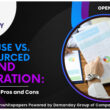In the ever-evolving landscape of the Banking, Financial Services, and Insurance (BFSI) sector, lead generation stands as a cornerstone for sustained growth and success. With the emergence of digital technologies and the vast amounts of data available, harnessing data insights has become pivotal for targeted marketing strategies in BFSI. This article explores the trends shaping lead generation in the BFSI sector and how businesses can leverage data insights to optimize their marketing efforts effectively.
Understanding the Importance of Lead Generation in BFSI
Lead generation plays a critical role in BFSI by identifying and attracting potential customers interested in financial products and services. Whether it’s acquiring new clients for banking services, insurance policies, or investment opportunities, effective lead generation ensures a steady stream of qualified prospects. In today’s competitive landscape, where consumers have numerous options at their fingertips, targeted marketing becomes essential to cut through the noise and capture the attention of the right audience.
Emerging Trends in BFSI Lead Generation
1. Data-Driven Approach
Data has emerged as a game-changer in BFSI lead generation. By leveraging advanced analytics and machine learning algorithms, financial institutions can extract valuable insights from customer data. These insights enable personalized marketing campaigns tailored to the specific needs and preferences of individual customers. From analyzing transaction history to predicting future financial needs, data-driven strategies empower BFSI businesses to target the right audience with the right message at the right time.
2. Omnichannel Marketing
In today’s digital age, consumers interact with BFSI brands across multiple channels, including websites, social media, mobile apps, and more. Omnichannel marketing ensures a seamless and consistent experience across all touchpoints, allowing financial institutions to engage with prospects wherever they are. By integrating data from various channels, BFSI businesses can gain a holistic view of customer behavior and preferences, enabling them to deliver personalized and relevant marketing messages across the entire customer journey.
3. Content Marketing
Content marketing has emerged as a powerful tool for lead generation in BFSI. By creating valuable and informative content, such as blog posts, articles, videos, and infographics, financial institutions can attract and engage potential customers at different stages of the buying cycle. From educating consumers about financial products to providing insights into industry trends, compelling content establishes trust and credibility, ultimately driving lead generation and customer acquisition.
4. Automation and AI
Automation and artificial intelligence (AI) are revolutionizing lead generation in BFSI by streamlining processes and enhancing efficiency. Chatbots, for example, can engage with website visitors in real time, answering questions, providing assistance, and capturing lead information. AI-powered algorithms can analyze vast amounts of data to identify patterns, predict customer behavior, and personalize marketing campaigns. By automating repetitive tasks and leveraging AI-driven insights, BFSI businesses can accelerate lead generation and improve conversion rates.
Harnessing Data Insights for Targeted Marketing
To harness data insights effectively for targeted marketing in BFSI, businesses must follow a structured approach:
1. Data Collection and Analysis
Start by collecting data from various sources, including customer interactions, website traffic, and social media engagement. Utilize data analytics tools to analyze this data and uncover valuable insights into customer behavior, preferences, and buying patterns.
2. Customer Segmentation
Segment your audience based on demographic, psychographic, and behavioral characteristics. By dividing your target market into distinct segments, you can tailor your marketing messages and offers to resonate with each group’s unique needs and preferences.
3. Personalized Communication
Craft personalized marketing messages that speak directly to the needs and interests of your target audience segments. Whether it’s sending targeted email campaigns, creating customized landing pages, or delivering personalized recommendations, personalized communication enhances engagement and drives lead generation.
4. Continuous Optimization
Monitor the performance of your marketing campaigns closely and use data analytics to track key metrics such as conversion rates, click-through rates, and return on investment (ROI). Continuously optimize your strategies based on these insights to improve campaign effectiveness and drive better results over time.
Conclusion
In conclusion, harnessing data insights is essential for successful lead generation in the BFSI sector. By adopting a data-driven approach, embracing emerging trends, and leveraging advanced technologies, financial institutions can optimize their marketing efforts and attract high-quality leads effectively. By understanding the importance of lead generation, embracing emerging trends, and implementing targeted marketing strategies, BFSI businesses can stay ahead of the competition and drive sustainable growth in today’s dynamic marketplace.


